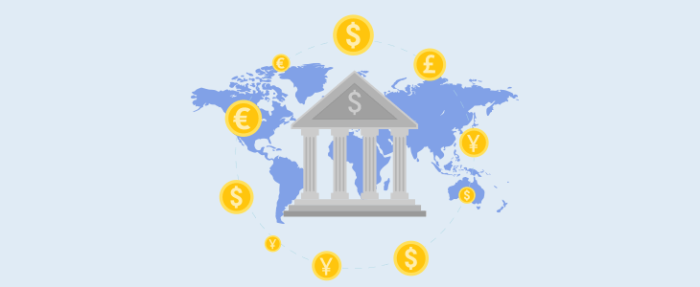Can You Open A Bank Account In Another Country? The answer, surprisingly, is often yes, but navigating the complexities of international banking requires careful planning and understanding. This journey involves more than simply filling out an application; it’s about understanding eligibility requirements, choosing the right account type, and being aware of the associated fees and tax implications. From residency stipulations and necessary documentation to the security measures protecting your funds, this guide unveils the intricacies of establishing a foreign bank account.
Opening a bank account abroad can unlock a world of financial opportunities, from managing international investments to simplifying overseas transactions. However, it’s a process that demands meticulous preparation. This comprehensive guide will walk you through each step, from determining your eligibility based on nationality and residency status to understanding the various account types available and the fees involved. We’ll also delve into crucial aspects like tax implications and security considerations to ensure a smooth and secure banking experience across borders.
The Process of Opening a Foreign Bank Account

Opening a bank account in a foreign country can seem daunting, but with careful planning and understanding of the process, it’s achievable. The specific requirements and procedures vary significantly depending on the country, the type of account, and your citizenship status. This section details the steps involved in both online and in-person applications, highlighting potential challenges you might encounter.
Opening a Foreign Bank Account Online
Opening a foreign bank account online offers convenience but often requires a higher level of digital verification. The process typically involves completing an online application form, providing identification documents, and potentially undergoing video verification.
- Account Selection: Research banks offering accounts suitable for your needs (personal, business, etc.) and check their eligibility criteria for non-residents.
- Application Completion: Fill out the online application form accurately and completely. This usually includes personal information, address, employment details, and the purpose of the account.
- Document Upload: Upload clear, high-resolution scans or photos of your required identification documents, such as passport, driver’s license, and proof of address. Ensure the documents meet the bank’s specified requirements regarding format and size.
- Verification: Undergo identity verification, often through a video call with a bank representative. You might be asked to show your identification documents to the camera and answer security questions.
- Funding: Once your application is approved, you may need to transfer funds into your new account to activate it. The method of funding will vary depending on the bank and your location.
Opening a Foreign Bank Account In-Person
The in-person process often involves visiting a branch of the foreign bank, scheduling an appointment, and presenting your documents in person. This method may be preferred by some banks, especially for high-value accounts or those requiring more complex verification processes.
- Appointment Scheduling: Contact the bank to schedule an appointment at a convenient branch location. This is crucial, as walk-ins may not be accepted for account openings.
- Document Preparation: Gather all necessary identification documents, proof of address, and any other supporting documentation requested by the bank. Having these organized and readily available will streamline the process.
- Branch Visit: Visit the designated branch at your scheduled appointment time. A bank representative will guide you through the application process and assist with completing the necessary paperwork.
- Account Activation: After completing the application and providing the necessary documentation, the bank will process your request. You may be able to activate your account immediately or it may take a few business days.
- Funding: Similar to online applications, funding the account is often a final step in activating the account.
Challenges in Opening a Foreign Bank Account
Several challenges can arise during the application process. These can include difficulties in meeting the bank’s stringent requirements for identification and proof of address, especially for non-residents. Language barriers, differing banking regulations, and the need for international wire transfers can also create obstacles. Banks may also require a minimum deposit amount or ongoing account maintenance fees. Furthermore, the specific requirements vary significantly between countries and even between different banks within the same country.
For example, banks in some countries might require a local sponsor or guarantor for non-residents.
Flowchart: Opening a Foreign Bank Account Remotely
The flowchart would visually represent the online process. It would start with “Select Bank and Account Type,” followed by “Complete Online Application,” then “Upload Documents,” and proceed to “Identity Verification.” Next, it would show “Application Approval/Rejection,” with approval leading to “Fund Account” and account activation, while rejection would lead to “Address Issues/Resubmit.” The final step would be “Account Activated.” Each step would be represented by a box, with arrows indicating the flow of the process.
This visual representation would clearly illustrate the sequential nature of the online account opening process.
Fees and Charges Associated with Foreign Bank Accounts
Opening a bank account in a foreign country offers numerous benefits, but it’s crucial to understand the associated costs. These fees can significantly impact the overall expense of maintaining an international account, potentially outweighing the advantages if not carefully considered. A thorough understanding of these charges is essential for making an informed decision.
Common Fees and Charges
Foreign bank accounts typically incur various fees. Monthly maintenance fees are common, charged for simply holding the account. Transaction fees apply to activities like withdrawals, deposits, and balance inquiries. International transfer fees are particularly significant, often levied for sending or receiving money across borders. These fees can vary widely depending on the amount transferred, the transfer method used, and the specific banks involved.
Additionally, some banks might charge fees for inactivity, exceeding account limits, or specific services like debit card usage or foreign currency exchange.
Comparative Fee Structures Across Banks and Countries
Fee structures vary considerably across different banks and countries. For instance, banks in Switzerland often have higher minimum balance requirements and maintenance fees compared to those in some Southeast Asian nations. Similarly, transaction fees can differ significantly; a simple ATM withdrawal might cost a few dollars in one country but substantially more in another. International transfer fees are especially variable, influenced by factors such as the transfer method (SWIFT, wire transfer), the currencies involved, and the recipient bank’s policies.
Some banks offer tiered fee structures, where fees decrease with higher account balances or transaction volumes. Others may charge flat fees regardless of the transaction amount. Researching several banks within your target country and comparing their fee schedules is crucial.
Calculating the Total Annual Cost
Estimating the total annual cost involves summing up all anticipated fees. For example, consider a hypothetical account with a $10 monthly maintenance fee, a $5 transaction fee per withdrawal, and a $25 fee for international transfers. If you anticipate making 12 withdrawals and one international transfer annually, the total annual cost would be: ($10/month
- 12 months) + ($5/withdrawal
- 12 withdrawals) + $25 = $215. This calculation, however, is a simplification. It doesn’t account for potential fees for other services or unexpected charges. Therefore, it’s essential to carefully review the bank’s complete fee schedule and make realistic estimates based on your projected account usage.
Comparative Fee Table for Three Banks
The following table compares the fees for three hypothetical banks (Bank A, Bank B, Bank C) across different transaction types. Remember that these are illustrative examples, and actual fees will vary depending on the specific bank, country, and account type.
| Bank | Monthly Maintenance Fee (USD) | ATM Withdrawal Fee (USD) | International Transfer Fee (USD) |
|---|---|---|---|
| Bank A | 15 | 3 | 30 |
| Bank B | 10 | 5 | 25 |
| Bank C | 5 | 2 | 40 |
Choosing the Right Bank and Account: Can You Open A Bank Account In Another Country

Opening a bank account in a foreign country requires careful consideration of several factors beyond simply finding a bank that accepts foreign clients. The right bank will depend heavily on your individual needs, the purpose of the account, and the length of your stay in the country. Selecting a suitable financial institution is crucial for ensuring secure and efficient management of your finances abroad.Choosing a bank involves comparing services, fees, accessibility, and the overall reputation of the institution.
A thorough evaluation will help mitigate potential risks and ensure a smooth banking experience.
Factors to Consider When Selecting a Foreign Bank
Several key factors should guide your decision when choosing a bank in a foreign country. These factors will directly impact the convenience, cost, and security of your banking experience.
- Account Fees and Charges: Examine the fees associated with account maintenance, transactions, transfers, and currency conversions. Compare these fees across different banks to identify the most cost-effective option for your anticipated usage.
- Services and Features: Consider the range of services offered, such as online banking, mobile banking, international money transfers, debit/credit cards, and ATM access. The availability of these services will significantly influence your day-to-day banking convenience.
- Accessibility and Branch Network: Assess the bank’s accessibility, including the availability of physical branches, ATMs, and online/mobile banking platforms. If you plan to frequently access your account, a wide branch network or readily available online services are essential.
- Reputation and Security: Research the bank’s reputation and financial stability. Choose a reputable institution with a strong track record and robust security measures to protect your funds.
- Language Support and Customer Service: Consider the language support offered by the bank. If you don’t speak the local language fluently, ensure the bank provides services in a language you understand. Efficient and responsive customer service is also vital.
- Regulatory Compliance: Ensure the bank complies with all relevant regulations and anti-money laundering (AML) laws. This is crucial to protect your financial interests and avoid legal complications.
Comparing Services and Features Offered by Different Banks
Direct comparison is crucial. A simple table can highlight key differences. For example, comparing HSBC, Citibank, and a local bank in a specific country (e.g., Spain) might reveal significant variations in account fees, online banking features, and international transfer options. HSBC and Citibank, being multinational institutions, often offer more extensive international services, but may charge higher fees than local banks.
Local banks might have better customer service in the local language but limited international transfer options.
Examples of Banks Known for Their International Services, Can You Open A Bank Account In Another Country
Several banks are renowned for their extensive international banking networks and services. These banks often cater to the needs of expats and individuals with international financial requirements. Examples include HSBC, Citibank, and Standard Chartered Bank. These institutions offer a range of services tailored to international clients, including multi-currency accounts, international money transfers, and global ATM access. However, it’s important to remember that their fees may be higher than those of local banks.
Decision-Making Matrix for Choosing a Bank
To facilitate a systematic comparison, a decision-making matrix is highly recommended. This matrix allows you to weigh the importance of different factors and compare banks based on your specific needs.
| Factor | Weight (1-5) | Bank A (Score) | Bank B (Score) | Bank C (Score) |
|---|---|---|---|---|
| Account Fees | 4 | 3 | 2 | 4 |
| Online Banking Features | 5 | 5 | 4 | 3 |
| International Transfer Fees | 3 | 2 | 3 | 1 |
| Branch Network | 2 | 1 | 4 | 3 |
| Customer Service | 4 | 4 | 3 | 2 |
| Security | 5 | 5 | 4 | 4 |
| Total Weighted Score | 24 | 24 | 17 |
Note: This is a sample matrix. You should adjust the weights and criteria based on your personal priorities. Scores (1-5) reflect a rating system where 5 is the best and 1 is the worst.
Successfully opening a bank account in another country hinges on meticulous preparation and a thorough understanding of the legal and financial landscape. From meeting stringent eligibility criteria and navigating diverse documentation requirements to selecting the appropriate account type and understanding the associated fees and tax implications, the process requires careful consideration. By weighing the pros and cons, understanding the security measures in place, and selecting a reputable institution, you can confidently establish a secure and beneficial financial presence abroad.
Remember, proactive research and diligent planning are key to a successful outcome.

